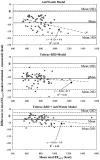Predicting energy expenditure of physical activity using hip- and wrist-worn accelerometers
- PMID: 14709206
- PMCID: PMC2901160
- DOI: 10.1089/152091503322641088
Predicting energy expenditure of physical activity using hip- and wrist-worn accelerometers
Abstract
To investigate the association between physical activity and health, we need accurate and detailed free-living physical activity measurements. The determination of energy expenditure of activity (EEACT) may also be useful in the treatment and maintenance of nutritional diseases such as diabetes mellitus. Minute-to-minute energy expenditure during a 24-h period was measured in 60 sedentary normal female volunteers (35.4 +/- 9.0 years, body mass index 30.0 +/- 5.9 kg/m2), using a state-of-the-art whole-room indirect calorimeter. The activities ranged from sedentary deskwork to walking and stepping at different intensities. Body movements were simultaneously measured using a hip-worn triaxial accelerometer (Tritrac-R3D, Hemokentics, Inc., Madison, Wisconsin) and a wrist-worn uniaxial accelerometer (ActiWatch AW64, MiniMitter Co., Sunriver, Oregon) on the dominant arm. Movement data from the accelerometers were used to develop nonlinear prediction models (separately and combined) to estimate EEACT and compared for accuracy. In a subgroup (n=12), a second 24-h study period was repeated for cross-validation of the combined model. The combined model, using Tritrac-R3D and ActiWatch, accurately estimated total EEACT (97.7 +/- 3.2% of the measured values, p=0.781), as compared with using ActiWatch (86.0 +/- 4.7%, p<0.001) or Tritrac-R3D (90.0 +/- 4.6%, p<0.001) alone. This model was also accurate for all intensity categories during various physical activities. The subgroup cross-validation also showed accurate and reproducible predictions by the combination model. In this study, we demonstrated that movement measured using accelerometers at the hip and wrist could be used to accurately predict EEACT of various types and intensity of activities. This concept can be extended to develop valid models for the accurate measurement of free-living energy metabolism in clinical populations.
Figures




Comment in
-
Actigraphy as metabolic ethography: measuring patterns of physical activity and energy expenditure.Diabetes Technol Ther. 2003;5(6):1035-7. doi: 10.1089/152091503322641097. Diabetes Technol Ther. 2003. PMID: 14709207 No abstract available.
Similar articles
-
The accuracy of the TriTrac-R3D accelerometer to estimate energy expenditure.Med Sci Sports Exerc. 1999 May;31(5):747-54. doi: 10.1097/00005768-199905000-00020. Med Sci Sports Exerc. 1999. PMID: 10331898
-
Distributed lag and spline modeling for predicting energy expenditure from accelerometry in youth.J Appl Physiol (1985). 2010 Feb;108(2):314-27. doi: 10.1152/japplphysiol.00374.2009. Epub 2009 Dec 3. J Appl Physiol (1985). 2010. PMID: 19959770 Free PMC article.
-
Assessment of energy expenditure for physical activity using a triaxial accelerometer.Med Sci Sports Exerc. 1994 Dec;26(12):1516-23. Med Sci Sports Exerc. 1994. PMID: 7869887
-
The Dilemma of Analyzing Physical Activity and Sedentary Behavior with Wrist Accelerometer Data: Challenges and Opportunities.J Clin Med. 2021 Dec 18;10(24):5951. doi: 10.3390/jcm10245951. J Clin Med. 2021. PMID: 34945247 Free PMC article. Review.
-
Physical activity assessment with accelerometers: an evaluation against doubly labeled water.Obesity (Silver Spring). 2007 Oct;15(10):2371-9. doi: 10.1038/oby.2007.281. Obesity (Silver Spring). 2007. PMID: 17925461 Review.
Cited by
-
Validity of six activity monitors in chronic obstructive pulmonary disease: a comparison with indirect calorimetry.PLoS One. 2012;7(6):e39198. doi: 10.1371/journal.pone.0039198. Epub 2012 Jun 20. PLoS One. 2012. PMID: 22745715 Free PMC article. Clinical Trial.
-
Review of physical activity measurement using accelerometers in older adults: considerations for research design and conduct.Prev Med. 2009 Feb;48(2):108-14. doi: 10.1016/j.ypmed.2008.12.001. Epub 2008 Dec 10. Prev Med. 2009. PMID: 19111780 Free PMC article. Review.
-
Ecological measurement of fatigue and fatigability in older adults with osteoarthritis.J Gerontol A Biol Sci Med Sci. 2010 Feb;65(2):184-9. doi: 10.1093/gerona/glp137. Epub 2009 Sep 23. J Gerontol A Biol Sci Med Sci. 2010. PMID: 19776216 Free PMC article.
-
Validity of activity monitors in health and chronic disease: a systematic review.Int J Behav Nutr Phys Act. 2012 Jul 9;9:84. doi: 10.1186/1479-5868-9-84. Int J Behav Nutr Phys Act. 2012. PMID: 22776399 Free PMC article.
-
Daily Level Association of Physical Activity and Performance on Ecological Momentary Cognitive Tests in Free-living Environments: A Mobile Health Observational Study.JMIR Mhealth Uhealth. 2022 Jan 31;10(1):e33747. doi: 10.2196/33747. JMIR Mhealth Uhealth. 2022. PMID: 35099402 Free PMC article.
References
-
- Blair SN, Kohl HW, Paffenbarger RS, Clark PG, Cooper CH, Gibbons LK. Physical fitness and all-cause mortality: a prospective study of healthy men and women. JAMA. 1989;262:2395–2401. - PubMed
-
- Paffenbarger RS, Hyde RT, Wing AL, Hsieh C. Physical activity, all-cause mortality, and longevity of college alumni. N Engl J Med. 1986;314:605–613. - PubMed
-
- Ainsworth BE, Basset DR, Strath SJ, Swartz AM, O'Brien WL, Thompson RW, Jones DA, Macera CA, Kimsey CD. Comparison of three methods for measuring the time spent in physical activity. Med Sci Sports Exerc. 2000;32(Suppl):S457–S464. - PubMed
-
- Paffenbarger RS, Blair S, Lee I, Hyde RT. Measurement of physical activity to assess health effects in free-living populations. Med Sci Sports Exerc. 1993;25:60–70. - PubMed
-
- Kriska A. Physical activity and the prevention of type 2 diabetes mellitus. Sports Med. 2000;29:147–151. - PubMed
Publication types
MeSH terms
Grants and funding
LinkOut - more resources
Full Text Sources
Other Literature Sources

